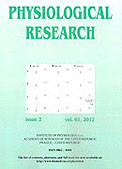Maxová H, Hezinová A, Vízek M. Physiol Res. 2011 60(5):831–4. IF: 1.646

Department of Pathophysiology
Abstract
Mechanism responsible for the enlargement of end-expiratory lung volume (EELV) induced by chronic hypoxia remains unclear. The fact that the increase in EELV persists after return to normoxia suggests involvement of morphological changes. Because hypoxia has been also shown to activate lung mast cells, we speculated that they could play in the mechanism increasing EELV similar role as in vessel remodeling in hypoxic pulmonary hypertension (HPH). We, therefore, tested an effect of mast cells degranulation blocker disodium cromoglycate (DSCG) on hypoxia induced EELV enlargement. Ventilatory parameters, EELV and right to left heart weight ratio (RV/LV + S) were measured in male Wistar rats. The experimental group (H + DSCG) was exposed to 3 weeks of normobaric hypoxia and treated with DSCG during the first four days of hypoxia, control group was exposed to hypoxia only (H), two others were kept in normoxia as non-treated (N) and treated (N + DSCG) groups. DSCG treatment significantly attenuated the EELV enlargement (H + DSCG = 6.1 ± 0.8; H = 9.2 ± 0.9; ml ± SE) together with the increase in minute ventilation (H + DSCG = 190 ± 8; H = 273 ± 10; ml/min ± SE) and RV/LV + S (H + DSCG = 0.39 ± 0.03; H = 0.50 ± 0.06).
-mk-
